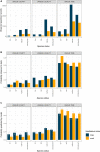Small herbaria contribute unique biogeographic records to county, locality, and temporal scales
- PMID: 33217783
- PMCID: PMC7756855
- DOI: 10.1002/ajb2.1563
Small herbaria contribute unique biogeographic records to county, locality, and temporal scales
Abstract
Premise: With digitization and data sharing initiatives underway over the last 15 years, an important need has been prioritizing specimens to digitize. Because duplicate specimens are shared among herbaria in exchange and gift programs, we investigated the extent to which unique biogeographic data are held in small herbaria vs. these data being redundant with those held by larger institutions. We evaluated the unique specimen contributions that small herbaria make to biogeographic understanding at county, locality, and temporal scales.
Methods: We sampled herbarium specimens of 40 plant taxa from each of eight states of the United States of America in four broad status categories: extremely rare, very rare, common native, and introduced. We gathered geographic information from specimens held by large (≥100,000 specimens) and small (<100,000 specimens) herbaria. We built generalized linear mixed models to assess which features of the collections may best predict unique contributions of herbaria and used an Akaike information criterion-based information-theoretic approach for our model selection to choose the best model for each scale.
Results: Small herbaria contributed unique specimens at all scales in proportion with their contribution of specimens to our data set. The best models for all scales were the full models that included the factors of species status and herbarium size when accounting for state as a random variable.
Conclusions: We demonstrated that small herbaria contribute unique information for research. It is clear that unique contributions cannot be predicted based on herbarium size alone. We must prioritize digitization and data sharing from herbaria of all sizes.
Keywords: Index Herbariorum; North American Network of Small Herbaria; Small Collections Network; biodiversity collection; biogeography; herbarium; natural history collection; rare plant; specimen; voucher.
© 2020 The Authors. American Journal of Botany published by Wiley Periodicals LLC on behalf of Botanical Society of America.
Figures



References
-
- Allen, J. R. 2018. Advancing digitization in the southern Rocky Mountain region. The Vasculum (newsletter of the Society of Herbarium Curators) 13: 9–12.
-
- Anderson, D. R. , and Burnham K. P.. 2002. Avoiding pitfalls when using information‐theoretic methods. Journal of Wildlife Management 66: 912–918.
-
- Ariño, A. H. , Chavan V., and Faith D. P.. 2013. Assessment of user needs of primary biodiversity data: Analysis, concerns, and challenges. Biodiversity Informatics 8: 59–63.
Publication types
MeSH terms
LinkOut - more resources
Full Text Sources

